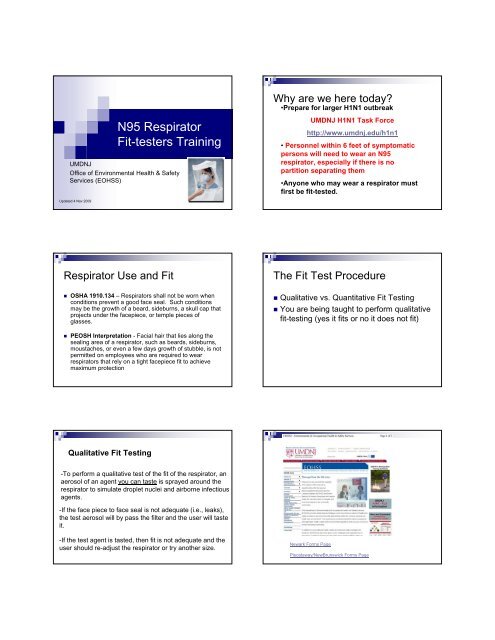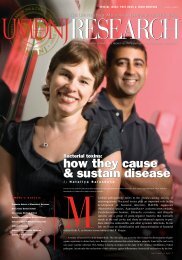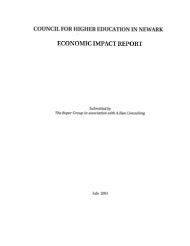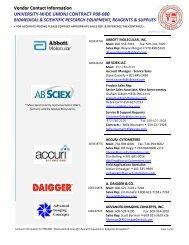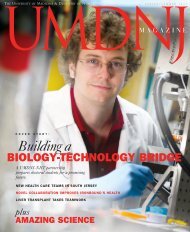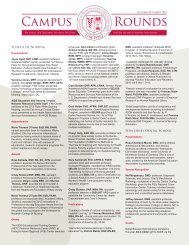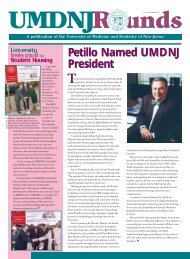N95 Respirator Fit-testers Training
N95 Respirator Fit-testers Training
N95 Respirator Fit-testers Training
Create successful ePaper yourself
Turn your PDF publications into a flip-book with our unique Google optimized e-Paper software.
<strong>N95</strong> <strong>Respirator</strong><br />
<strong>Fit</strong>-<strong>testers</strong> <strong>Training</strong><br />
UMDNJ<br />
Office of Environmental Health & Safety<br />
Services (EOHSS)<br />
Updated 4 Nov 2009<br />
<strong>Respirator</strong> Use and <strong>Fit</strong><br />
� OSHA 1910.134 – <strong>Respirator</strong>s shall not be worn when<br />
conditions prevent a good face seal. Such conditions<br />
may be the growth of a beard, sideburns, a skull cap that<br />
projects under the facepiece, or temple pieces of<br />
glasses.<br />
� PEOSH Interpretation - Facial hair that lies along the<br />
sealing area of a respirator, such as beards, sideburns,<br />
moustaches, or even a few days growth of stubble, is not<br />
permitted on employees who are required to wear<br />
respirators that rely on a tight facepiece fit to achieve<br />
maximum protection<br />
Qualitative <strong>Fit</strong> Testing<br />
-To perform a qualitative test of the fit of the respirator, an<br />
aerosol of an agent you can taste is sprayed around the<br />
respirator to simulate droplet nuclei and airborne infectious<br />
agents.<br />
-If the face piece to face seal is not adequate (i.e., leaks),<br />
the test aerosol will by pass the filter and the user will taste<br />
it.<br />
-If the test agent is tasted, then fit is not adequate and the<br />
user should re-adjust the respirator or try another size.<br />
Why are we here today?<br />
•Prepare for larger H1N1 outbreak<br />
UMDNJ H1N1 Task Force<br />
http://www.umdnj.edu/h1n1<br />
• Personnel within 6 feet of symptomatic<br />
persons will need to wear an <strong>N95</strong><br />
respirator, especially if there is no<br />
partition separating them<br />
•Anyone who may wear a respirator must<br />
first be fit-tested.<br />
The <strong>Fit</strong> Test Procedure<br />
� Qualitative vs. Quantitative <strong>Fit</strong> Testing<br />
� You are being taught to perform qualitative<br />
fit-testing (yes it fits or no it does not fit)<br />
Newark Forms Page<br />
Piscataway/NewBrunswick Forms Page
<strong>Respirator</strong>y use is one of many<br />
Control Measures<br />
•Administrative measures -promptly identify, segregate, and treat<br />
suspect or active patients. Symptomatic patients must wear a face<br />
mask<br />
• Vaccination (~2 weeks for immunity to develop)<br />
• Work Practices – Hand hygiene<br />
• Engineering controls such as ventilation (negative pressure<br />
isolation rooms), booths with high efficiency filters, and HEPA filtration<br />
equipment, glass partitions for frontline personnel<br />
• <strong>Respirator</strong>y protection and other personal protective equipment<br />
- Last line of defense<br />
Commercial unavailability of <strong>N95</strong>s<br />
OSHA Prioritized Use Mode<br />
� Since a shortage of disposable <strong>N95</strong> respirators is possible,<br />
employers are advised to monitor their supply, prioritize their use of<br />
disposable <strong>N95</strong> respirators and to consider the use of elastomeric<br />
respirators and facemasks if severe shortages occur.<br />
� Employer must prioritize use of respirators to ensure that sufficient<br />
respirators are available for providing close-contact care for patients<br />
with tuberculosis.<br />
� Healthcare workers performing high hazard aerosol-generating<br />
procedures (e.g., bronchoscopy, open suctioning of airways, etc.)<br />
on a suspected or confirmed TB or H1N1 patient must always use<br />
at least a fit-tested <strong>N95</strong>, even where a respirator shortage exists.<br />
� For low risk exposures (not conducting procedures where aerosols<br />
produced, no direct patient contact) to H1N1, a surgical mask is<br />
better than nothing – resistant to splashes, prevents wearer from<br />
touching nose and mouth<br />
<strong>N95</strong> Particulate <strong>Respirator</strong><br />
� The N designation<br />
means the respirator<br />
is designed to be<br />
used to filter aerosols<br />
free of oil. (N=not oil)<br />
� 95 means a filter<br />
efficiency level of<br />
95% for hardest to<br />
filter particles (.3<br />
microns).<br />
When should a respirator be<br />
worn for H1N1?<br />
<strong>Respirator</strong>s should be worn:<br />
• When in close contact (within 6 feet) of<br />
patients with symptoms of H1N1 or seasonal<br />
influenza (flu)<br />
•Risk Assessment – may not be necessary to<br />
change the respirator between patients if there<br />
is no direct patient contact (e.g. person behind<br />
a partition, housekeeping)<br />
Examples of <strong>N95</strong> <strong>Respirator</strong>s<br />
These respirators are also<br />
known as N-95 disposable<br />
respirators.<br />
3M 1870 Healthcare Particulate<br />
and Surgical Mask (Latex Free)<br />
Sizes: “one size fits most”<br />
North 7130 (Latex Free)<br />
Sizes: One Size<br />
Tecnol PFR-95 (Latex free)<br />
Sizes: Regular and Small<br />
<strong>N95</strong> Particulate <strong>Respirator</strong><br />
� Intended to reduce<br />
wearer exposure to<br />
certain airborne<br />
particles in a size<br />
range of 0.1 to<br />
>10.0 microns<br />
� Fluid resistant to<br />
splash and splatter
<strong>N95</strong> <strong>Respirator</strong> Limitations<br />
� Proper fit is critical to respirator performance.<br />
� Designed for filtering of particles only; Will not<br />
filter gases or vapors.<br />
� May be uncomfortable if used for extended<br />
periods.<br />
� Can not be worn by individuals with facial hair<br />
(beards, goatees, etc.).<br />
� Need to replace if wet, damaged, heavily soiled<br />
or contaminated.<br />
� Is less protective that a respiratory with a higher<br />
assigned protection factor<br />
Examples of Elastiomeric <strong>Respirator</strong>s (for high risk situations where<br />
<strong>N95</strong>s are commercially unavailable)<br />
Half face Elastiomeric<br />
Full Face Elastiomeric<br />
These would need to be used with a HEPA cartridge<br />
Powered Air Purifying<br />
<strong>Respirator</strong>s (PAPR) PAPRs are positive<br />
pressure- if there is<br />
any leakage, clean<br />
air leaks out of the<br />
mask<br />
If Worn Properly…….<br />
� An air purifying respirator will reduce, but<br />
not eliminate the inhalation of aerosol<br />
contaminants.<br />
� Does not supply oxygen.<br />
� Does not totally eliminate exposure to or risk<br />
of contracting any disease or infection.<br />
� PAPRs are more protective<br />
<strong>N95</strong> and Elastiomeric are Negative<br />
Pressure <strong>Respirator</strong>s<br />
This means they require the user to inhale<br />
(creating a negative pressure inside the<br />
respirator) in order to draw air inside the<br />
respirator.<br />
If there is any leakage, then contaminated<br />
air leaks into the mask.<br />
Why do we need to fit test <strong>N95</strong>s?<br />
<strong>Fit</strong>-testing is an OSHA Requirement<br />
We need to ensure that contaminated air does not enter<br />
the respirator around the facepiece.<br />
When you inhale, if the face piece does not fit correctly<br />
(i.e., there are openings or gaps), the air will enter through<br />
these openings instead of passing through the respirator<br />
filter.<br />
Everyone must be fit tested before being assigned a<br />
respirator to ensure that they have the size and respirator<br />
model that will provide the best fit.
Repeat fit-testing annually, and<br />
when:<br />
� changes in facial structure such as from the<br />
following situations:<br />
� weight loss or gain greater than +/- 5 pounds<br />
� dental/denture changes,<br />
� facial scarring,<br />
� facial surgery,<br />
� or other conditions which interfere with the seal<br />
of the face piece.<br />
Written Plan<br />
Your department may have its own <strong>Respirator</strong>y Protection Plan or it may<br />
use the UMDNJ Clinical <strong>Respirator</strong>y Protection Plan posted at<br />
http://www2.umdnj.edu/eohssweb/publications/<br />
repiratory_protection_plan.pdf<br />
The UMDNJ Plan is designed to be customized for each unit/department by<br />
completion of fill-in-the-blanks.<br />
Medical Surveillance<br />
� Your school/unit/department must have<br />
arrangements with a licensed healthcare<br />
provider (usually the campus Employee<br />
Health/Occupational Medicine Service)<br />
� No specific requirement for how often<br />
medical clearance must be obtained<br />
�Request for Medical Evaluation for <strong>Respirator</strong><br />
Wearer (when completed by Provider, this<br />
serves as documentation of Medical Clearance)<br />
�<strong>Respirator</strong> Wearer’s confidential Questionnaire<br />
Summary of OSHA Requirements:<br />
29 CFR 1910.134:<br />
<strong>Respirator</strong>y Protection Standard<br />
� Written <strong>Respirator</strong>y Protection Plan describing Program<br />
� Annual <strong>Respirator</strong>y Protection <strong>Training</strong> in the proper use,<br />
limitations, leak-testing, and storage of the respirator and<br />
in the hazard being protected against<br />
� <strong>Respirator</strong> Wearer Medical Surveillance to determine if<br />
the employee is cleared to wear a respirator<br />
� Annual <strong>Respirator</strong> Wearer <strong>Fit</strong>-Test to ensure that the<br />
respirator fits and will not allow contaminated air to leak<br />
into the breathing area from around the face piece.<br />
Annual <strong>Training</strong><br />
EOHSS has an online respiratory protection training module posted at<br />
http://www2.umdnj.edu/eohssweb/publications/resp_training.htm<br />
Hands on training in donning<br />
and doffing the respirator and<br />
leak checking is part of the<br />
fit-testing procedure<br />
The EOHSS online training<br />
module has been updated<br />
to address H1N1<br />
<strong>Fit</strong>-testing<br />
� Only people with<br />
documented training<br />
can perform fittesting
Procedure for <strong>Fit</strong> Testers<br />
Step 1 – A week before the session inform<br />
people to be fit-tested of the requirements<br />
for being fit-tested<br />
� Inform them of the address of the respiratory protection module:<br />
http://www2.umdnj.edu/eohssweb/publications/resp_training.htm<br />
and that training takes about 20-25 minutes and that they must bring<br />
the email documentation of training they received after completion to<br />
the fit-testing session.<br />
� If they don’t have documentation of medical clearance they need to get<br />
it- how to get it: download forms from<br />
http://www2.umdnj.edu/eohssweb/publications/fit_test.htm<br />
� the supervisor should fill out the Request for Medical Evaluation for <strong>Respirator</strong> Use<br />
form<br />
� The person being fit-tested should complete the <strong>N95</strong> Medical Evaluation<br />
Questionnaire, put it in a sealed envelope and give it to the supervisor to be sent<br />
along with the request form to the campus employee health or other provider. In<br />
many cases people get medical clearance without the need for a medical<br />
appointment.<br />
Step 2 – Get supplies ready<br />
� Qualitative <strong>Fit</strong> test kit<br />
� Variety of <strong>N95</strong> respirators (sizes/models)<br />
� Water/cups for people to drink between<br />
tests<br />
� Handouts, <strong>Fit</strong> Test Protocol <strong>Respirator</strong>y<br />
Protection Medical Status Update form, and<br />
<strong>Fit</strong> Test Record forms (download from<br />
http://www2.umdnj.edu/eohssweb/publications/fit_test.htm )<br />
� Disinfecting wipes and paper towel (for<br />
cleaning and then drying the fit-test hood<br />
between uses<br />
� You may want to bring shaving supplies for<br />
people who arrive with facial hair<br />
Summary-Procedure for fit <strong>testers</strong><br />
� Handouts, forms and the fit-test protocol are posted on the EOHSS website<br />
at: http://www2.umdnj.edu/eohssweb/publications/fit_test.htm<br />
� People being fit-tested must give you:<br />
a) documentation that they have completed respiratory<br />
protection training in the past year and<br />
b) documentation that they have received medical clearance (it does not<br />
have to be recent) to wear a respirator before you fit-test them.<br />
� People being fit-tested must complete:<br />
a) <strong>Respirator</strong> Medical Reevaluation form before being fit-tested, even if<br />
their medical clearance is recent. People who answer “yes” on the form<br />
should not be fit-tested. They will need to complete the respirator wearers’<br />
confidential questionnaire so that occupational medicine/Employee Health<br />
Service can decide if they should be medically cleared or if they need an<br />
office visit.<br />
b) Should complete the appropriate section of the fit-test record form while<br />
waiting to be fit-tested<br />
� Completed forms should be given to the person coordinating the<br />
<strong>Respirator</strong>y Protection program for your unit/department.<br />
Step 1 (continued)– A week before the<br />
session inform people to be fit-tested of the<br />
requirements for being fit-tested:<br />
� They must not eat, drink or chew gum for<br />
at least 15 minutes before the session<br />
� Men must be clean shaven<br />
Step 3 – Obtain two types of documentation<br />
before fit-testing each person<br />
Documentation That Must Be Provided<br />
1-documentation of Medical Clearance<br />
2-documentation of completion of respiratory protection training<br />
<strong>Respirator</strong>y <strong>Training</strong> can be completed online at<br />
http://www2.umdnj.edu/eohssweb/publications/resp_training.htm<br />
•OSHA does not specify frequency of Medical Evaluations so it does<br />
not need to be current<br />
•The training must have been completed in the past year.
Step 4 – Each person being fit-tested<br />
must first give the fit-tester a completed<br />
Medical Status Update Questionnaire<br />
The questionnaire is posted at:<br />
http://www2.umdnj.edu/eohssweb/publications/respiratory_protection_medical_status_update.pdf<br />
The questionnaire asks if there have been medical or<br />
psychological conditions since their last evaluation<br />
People who answer “yes” should not be fit-tested.<br />
They need new medical clearance before being fit<br />
tested.<br />
Step 5 – Before conducting the fit-test,<br />
check for facial hair - Persons who<br />
have Facial Hair must not be fit tested<br />
� Beards, stubble, or sideburns will prevent<br />
a good facepiece seal.<br />
� If practical, have shaving supplies<br />
available.<br />
� No exception to this rule<br />
Step 6 (cont) -Sensitivity Test<br />
� The test hood is placed<br />
over the subject’s head<br />
(without the respirator on)<br />
and the sensitivity<br />
solution is misted inside<br />
to make sure the subject<br />
can detect the test<br />
solution.<br />
� If the subject can not<br />
detect the solution after<br />
30 squirts a different test<br />
agent must be used or<br />
the fit-testing cannot be<br />
performed.<br />
Medical Reasons That Could<br />
Prohibit the Use of a <strong>Respirator</strong><br />
� A history of pulmonary or lung problems<br />
such as:<br />
� Asbestosis, asthma, COPD, emphysema,<br />
TB, silicosis, shortness of breath, etc.<br />
� Do not use a respirator if you have any<br />
health or respiratory problem until you<br />
obtain clearance from a Physician or other<br />
Licensed Health Care Professional.<br />
Step 6 – Before the fit-test, perform<br />
the Sensitivity Test<br />
This test is done to assure that the person<br />
being tested can detect the sweet or bitter<br />
taste of the test solution at very low levels.<br />
The Sensitivity Test Solution is a very<br />
dilute version of the <strong>Fit</strong> Test Solution. The<br />
test subject should not eat, drink, or chew<br />
gum for 15 minutes before the test.<br />
Step 7 – Show the person being fit-tested<br />
how to inspect the respirator, don the<br />
respirator, and how to perform the positive<br />
and negative leak test<br />
� Select the appropriate size<br />
depending upon the size of the<br />
person’s face.<br />
� Inspect the respirator for<br />
defects.<br />
� Stretch the elastic straps<br />
slightly<br />
� Follow donning instructions on<br />
the box
Donning an <strong>N95</strong><br />
� Using both hands,<br />
starting at the top of the<br />
respirator, mold the nose<br />
clip around your nose to<br />
achieve a good face-torespirator<br />
seal<br />
� Do not pinch the nose clip<br />
with one hand<br />
A properly donned <strong>N95</strong>respirator<br />
� The respirator must be<br />
correctly oriented on the face<br />
and held in position with both<br />
straps.<br />
� The straps must be correctly<br />
placed, with the upper strap<br />
high on the head and the lower<br />
strap below the ears.<br />
� For persons with long hair, the<br />
lower strap should be placed<br />
under (not over) the hair.<br />
� The nose clip must be<br />
tightened using both hands to<br />
avoid gaps between the<br />
respirator and the skin.<br />
RESPIRATOR FIT CHECKS<br />
Perform both a Positive Pressure Seal Check<br />
and a Negative Pressure Seal Check<br />
Positive Pressure Seal<br />
Check:<br />
With the respirator securely<br />
in place exhale greatly. The<br />
respirator will bulge slightly.<br />
If air leaks between the face<br />
and the face-seal of the<br />
respirator, reposition it and<br />
readjust the nose clip for a<br />
more secure seal.<br />
<strong>Respirator</strong> Donning (continued)<br />
It is important to take the time to put on the respirator<br />
correctly each time it is worn!<br />
<strong>Respirator</strong> <strong>Fit</strong> Check<br />
•If the solution is detected at any time during<br />
the test: STOP! Instruct subject to remove the<br />
hood and mask; take a sip of water. Re-adjust<br />
the <strong>N95</strong> and try again or try a different<br />
size/model<br />
•Remind people being fit-tested that it is<br />
important to check the seal of the respirator by<br />
each time it is put on by performing the fit test.<br />
RESPIRATOR FIT CHECKS<br />
Negative Pressure Seal Check:<br />
With the respirator<br />
securely in place inhale<br />
greatly. The respirator<br />
will collapse slightly. If<br />
air leaks between the<br />
face and the face-seal<br />
of the respirator,<br />
reposition it and<br />
readjust the nose clip<br />
for a more secure seal.
<strong>Respirator</strong> Shaped Like<br />
a Tecnol Fluidshield<br />
Open respirator<br />
and pull out and<br />
separate the<br />
straps inside….<br />
Hold respirator up to face pulling both<br />
straps over head, ensuring that the straps<br />
are not twisted.<br />
�the lower strap should be below the ear<br />
�the top strap should be as far up on the<br />
crown of head as possible…..<br />
Donning a North <strong>N95</strong><br />
demonstration<br />
http://www2.umdnj.edu/eohssweb/publications/north.wmv<br />
Step 8 – Perform the qualitative<br />
fit test<br />
Follow the instructions<br />
on the <strong>N95</strong> <strong>Respirator</strong><br />
<strong>Fit</strong>-test Protocol<br />
Available at:<br />
http://www2.umdnj.edu/eohssweb/<br />
publications/n95_qualitative_<strong>Fit</strong>_T<br />
est_Protocol.pdf<br />
<strong>Respirator</strong> Shaped Like<br />
a Tecnol Fluidshield (continued)<br />
Adjust nosepiece to<br />
conform around bridge<br />
of nose….<br />
Perform both positive and<br />
negative seal check tests.<br />
Donning Kimberly Clark <strong>N95</strong><br />
http://www2.umdnj.edu/eohssweb/publications/kimberlyclark.wmv<br />
Step 8 (cont.)– Overview of How<br />
to Perform the Qualitative <strong>Fit</strong> Test<br />
After the subject dons the respirator and<br />
performs a positive and negative fit, the hood is<br />
again placed over the head and the <strong>Fit</strong> Test<br />
Solution (a very concentrated saccharin or Bitrex<br />
solution) is misted into the hood.
Step 8 (cont)The instructor then prompts<br />
the wearer to perform a series of seven 1minute<br />
‘tests’ that are designed to<br />
challenge the seal of the mask<br />
� Normal breathing;<br />
� Intermittent deep breathes;<br />
� Turning head side-to-side;<br />
� Nodding head up and down;<br />
� Speaking out loud – The Rainbow Passage;<br />
� Running in place, bending (designed to raise your heart<br />
rate!);<br />
� Normal breathing<br />
Step 9 – Complete and sign the<br />
<strong>Fit</strong>-test record.<br />
� Give the completed and signed forms to<br />
the person who is coordinating the<br />
respiratory protection program for your<br />
department<br />
� The person coordinating the program for<br />
your department should ensure that<br />
personnel are informed of which<br />
respirators they were successfully fittested<br />
on.<br />
How often should <strong>N95</strong> respirators be<br />
replaced?<br />
• as required by infection control procedures<br />
(generally speaking, between patients)<br />
•if resp is contaminated with blood or body fluids<br />
•if resp becomes wet or moist<br />
•if resp is damaged<br />
•if you have difficulty breathing<br />
•After direct contact with a person with symptoms<br />
of infuenza (within 6 feet, not behind a partition<br />
Qualitative <strong>Fit</strong> Testing<br />
Once a person has been successfully fit tested<br />
with a particular respirator, inform the person the<br />
brand and model number of the respirator that<br />
passed the fit-test. This is the only size and<br />
model that should used.<br />
Do not switch to another model or<br />
size for any reason without obtaining<br />
another fit test.<br />
A few more things to know<br />
about <strong>N95</strong>s…<br />
Removing an <strong>N95</strong><br />
� If the respirator is grossly contaminated<br />
with sputum or other bodily fluids only<br />
handle the straps.<br />
� To remove<br />
�First pull lower strap over the head<br />
�Second – remove the upper strap<br />
� Discard the respirator if it is contaminated<br />
or damaged
Care of an <strong>N95</strong><br />
� Must be replaced if<br />
wet or damaged.<br />
� Replace if<br />
contaminated (i.e.<br />
sputum or other bodily<br />
fluids)<br />
� Do not crease or fold<br />
� Do not write on the<br />
mask. It is ok to write<br />
on the strap<br />
contact:<br />
Questions? Problems?<br />
eohsshelp@umdnj.edu<br />
Your campus EOHSS office:<br />
Newark/Scotch Plains 2-4812<br />
Piscataway/New Brunswick 5-4058<br />
Stratford/Camden 6-6189<br />
Storage<br />
� Store unused <strong>N95</strong>s in a large resealable<br />
storage bag (i.e. “zip lock” bag). However,<br />
do not seal the bag when the respirator is<br />
wet.


